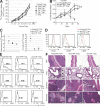A critical role for regulatory T cell-mediated control of inflammation in the absence of commensal microbiota
- PMID: 20921284
- PMCID: PMC2964571
- DOI: 10.1084/jem.20101235
A critical role for regulatory T cell-mediated control of inflammation in the absence of commensal microbiota
Abstract
Suppression mediated by regulatory T cells (T reg cells) represents a unique, cell-extrinsic mechanism of in-trans negative regulation that restrains multiple types of immune cells. The loss of T reg cells leads to fatal, highly aggressive, and widespread immune-mediated lesions. This severe autoimmunity may be driven by commensal microbiota, the largest source of non-self ligands activating the innate and adaptive immune systems. Alternatively, T reg cells may primarily restrain T cells with a diverse self-major histocompatibility complex (MHC)-restricted T cell receptor repertoire independently of commensal microbiota. In this study, we demonstrate that in germ-free (GF) mice, ablation of the otherwise fully functional T reg cells resulted in a systemic autoimmune lympho- and myeloproliferative syndrome and tissue inflammation comparable with those in T reg cell-ablated conventional mice. Importantly, there were two exceptions: in GF mice deprived of T reg cells, the inflammation in the small intestine was delayed, whereas exocrine pancreatitis was markedly accelerated compared with T reg cell-ablated conventional mice. These findings suggest that the main function of T reg cells is restraint of self-MHC-restricted T cell responsiveness, which, regardless of the presence of commensal microbiota, poses a threat of autoimmunity.
Figures




References
-
- Bennett C.L., Christie J., Ramsdell F., Brunkow M.E., Ferguson P.J., Whitesell L., Kelly T.E., Saulsbury F.T., Chance P.F., Ochs H.D. 2001. The immune dysregulation, polyendocrinopathy, enteropathy, X-linked syndrome (IPEX) is caused by mutations of FOXP3. Nat. Genet. 27:20–21 10.1038/83713 - DOI - PubMed
-
- Brunkow M.E., Jeffery E.W., Hjerrild K.A., Paeper B., Clark L.B., Yasayko S.A., Wilkinson J.E., Galas D., Ziegler S.F., Ramsdell F. 2001. Disruption of a new forkhead/winged-helix protein, scurfin, results in the fatal lymphoproliferative disorder of the scurfy mouse. Nat. Genet. 27:68–73 10.1038/83784 - DOI - PubMed
Publication types
MeSH terms
Grants and funding
LinkOut - more resources
Full Text Sources
Other Literature Sources
Medical
Research Materials

